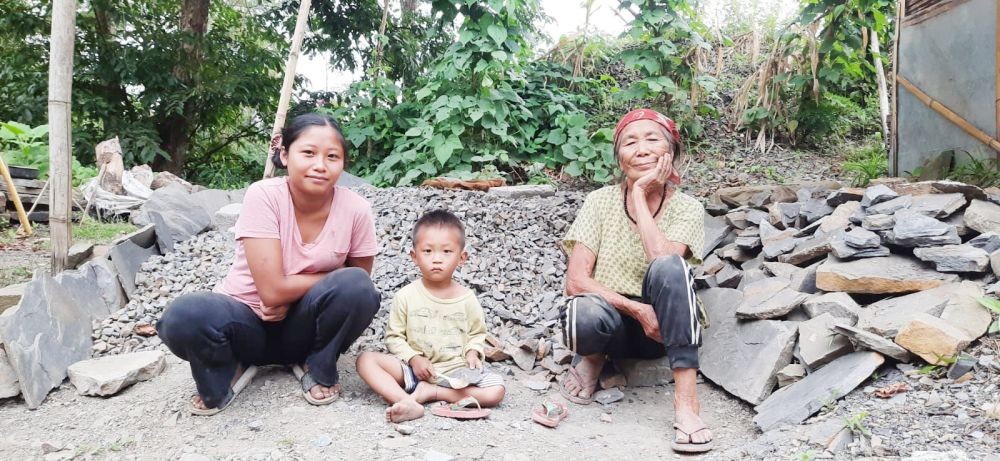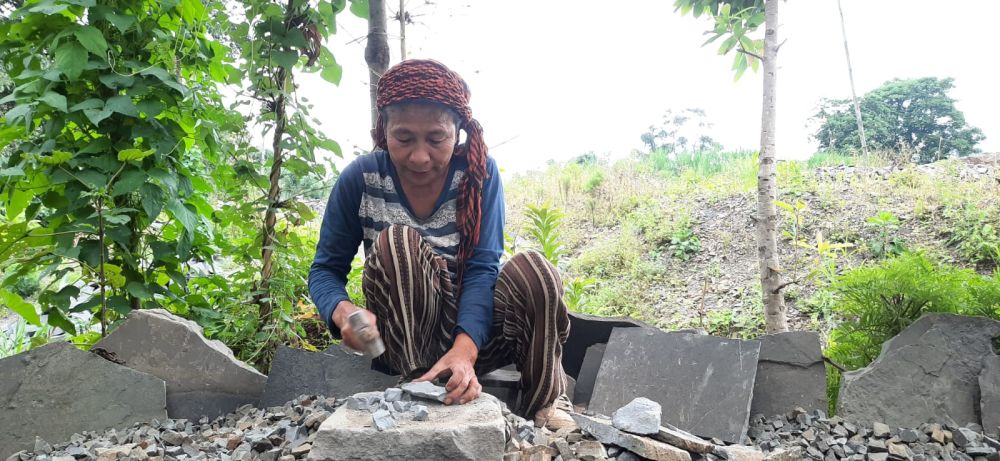Akala with her two-year-old son at her work site in Mokokchung. (Morung Photo)

Limasenla Jamir
Mokokchung | October 11
It is widely held that men predominate the construction sector and official data affirm such a viewpoint.
According to data provided by the Nagaland Building and Other Construction Workers Welfare Board (NBOCWWB) Regional Office Mokokchung, out of 1729 active registered construction workers in the district, only 311 are women.
Overall, 3702 persons are registered as construction workers in Mokokchung district.

Lipokienla busy breaking stone chips near a stone quarry in Mokokchung.
Why gender differences?
The significant gender difference is explained by several issues, including unconscious gender bias, a lack of proper training, and the unfavorable views of women working in the construction industry.
Traditionally, women were not allowed to perform any heavy tasks such as carrying of heavy loads or engaging in construction of houses or clearing of jungle paths because it was believed that the physical strength of a man and a woman was different, explained R Longritemjen Ao, Chairman of Aongza Ward.
“In our Naga society, men do not expect women to do construction work and women also think it is not their forte,” maintained Tsukti Longkumer, Managing Director, Longpok Holdings, in contrast with other countries where they are taking major roles and many avenues are there for women in the sector.
However, he said that though women cannot engage in the construction sector individually, perhaps, they will be accepted if they create teams and work as a group.
While women can do a lot of things better that men do in many job sectors, due to the difference in physical strength, people tend to trust men more in construction works, noted Dr Kilangwapang Pongen, a doctor at the Imkongliba Memorial District Hospital, Mokokchung.
“From the beginning of human civilization, there was a division of labour between men and women. The types of work changed in due course of time, but the division of labour remained unchanged,” he added.
However, Loina Shohe, an Assistant Professor in the Department of Sociology in Nagaland University located “invisibility of women” in the construction sector in the Naga context to patriarchal nature of Naga society and its accompanying value on gender roles.
“Despite the introduction of modern education and democratic values, patriarchal expressions such as ideas of which works are to be performed by which gender still persists,” she argued.
“Traditionally, construction work was the domain of men. Hence, even in contemporary context, many women do not want to engage in a job defined as a non-womanly job, and since these domains have been occupied only by men for a long time, women lack the necessary skills, and even if some of them were interested, it's possible that employers wouldn't hire them,” Loina said.
‘A woman's family might not be supportive of her decision to enter a field that is predominately male,” she added.
Breaking barriers
Despite those barriers, a few Naga women have continued to build their path in the construction sector by working in coal mines in Mon, and stone quarries in Mokokchung and Wokha districts, and construction sites in Dimapur; and along with few technical and managerial roles in Dimapur and Kohima.
One such woman is Lipokienla Jamir, a 56-year-old mother of four children from Mokokchung, engaged in construction sector for the past twenty years, crushing stones in stone quarries.
With the increase in the expense of cultivating rice, along with her husband, she decided to engage in stone quarrying as it brings more money than farming.
Likewise, Akala, 23-year-old mother of one, works with her husband in a stone quarry near Marepkong ward in Mokokchung.
She comes with her husband and two-year-old son daily to the site and breaks stone chips, which are then sold for around Rs 3000 for a load of pick-up truck.
With only hands and a hammer as working tools, it takes about a week or more to fill a truck, she informed.
Altogether, there are around twenty women helping their husbands in the stone quarries and earning their livelihood, especially in Ungma village of Mokokchung district.
For Oshy Longkumer, a Post-Graduate Teacher in a government school, while agreeing that men are physically stronger and undertaking manual labour could be more difficult for women, noted that there are no distinctions in skills between them.
“Women are, in fact, the ones who do most of the housework or even work in the field,” she asserted.
As a career in the construction field, women can take roles of supervisor, architect, engineer, project manager, financial manager, and so on, she elaborated, adding that Naga women can build a career out of it.
“There have been numerous instances of Naga women supervising the construction of their own houses. Therefore, someone simply needs to go out there, tear down the boundaries, and be the change,” she contended.
The disparity of men and women in the construction sector is both environmental and societal, making it seem ‘unbreachable.’ However, more than discrimination, it is a habit based on past precedence and preconceived notions.
Construction has traditionally been a male domain, not just in Naga society but also in India and the rest of the world. Therefore, it is uncertain whether the glass barrier can be breached.
This is the second of a five-part series highlighting the experiences and challenges faced by the construction industry in Nagaland, as part of the Kohima Press Club and Nagaland Building and Other Construction Workers Welfare Board Media Fellowship.






